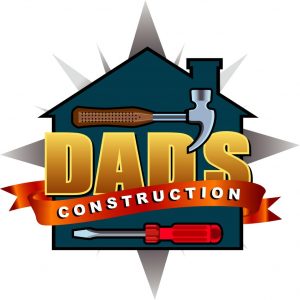Cabinet Doors
How do you select cabinet doors for your bathroom or kitchen? Typing “Cabinet Doors” in Google returns over 350 million results! That’s not helpful! How a cabinet door is made is the most important consideration. There are basically 3 types of cabinet doors. These are solid wood, particle board (Melamine Faced Chipboard or MFC), MDF and HDF (Medium-Density Fibreboard and High-Density Fiberboard).
What is the difference in these materials when considering cabinet doors?
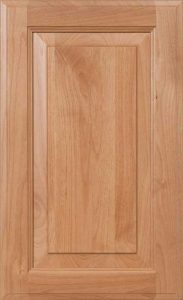 | 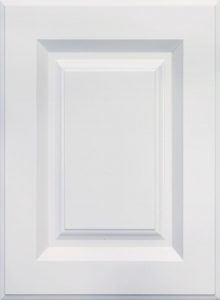 |  |
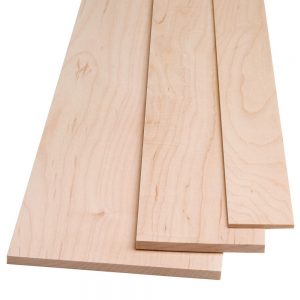 | 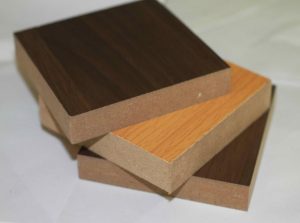 | 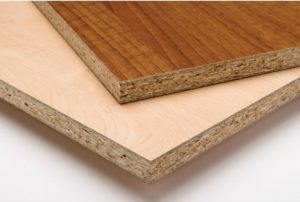 |
| Solid Wood | MDF and HDF | Particle Board (MFC) |
Solid Wood Cabinet Doors
 Solid wood cabinet doors are derived from timber-yielding trees. Logs obtained from felled trees are cut into various board sizes. Wood is much stronger than MDF, HDF, and particle board. Wood has natural, enduring beauty and lasts a lifetime. Solid wood can be shaped, stained, and painted to virtually any preference.
Solid wood cabinet doors are derived from timber-yielding trees. Logs obtained from felled trees are cut into various board sizes. Wood is much stronger than MDF, HDF, and particle board. Wood has natural, enduring beauty and lasts a lifetime. Solid wood can be shaped, stained, and painted to virtually any preference.
Natural wood contains no harmful formaldehyde. This is my number one choice for cabinet doors. You can’t beat the lasting beauty, quality, strength, and safety of real solid wood.
MDF and HDF Cabinet Doors
 MDF and HDF takes a much crisper edge than particleboard (MFC). Made from very small wood fibers (almost like flour). This engineered lumber product uses urea-formaldehyde resin adhesives to bond the fine sawdust together. Formaldehyde is suspected of being a carcinogen, and MDF and HDF have some of the highest concentration of urea-formaldehyde adhesives out of all the engineered wood products that use it. Water and heat will quickly destroy MDF and HDF. Thermofoil finishes tend to separate from MDF and HDF. Both are susceptible to yellowing.
MDF and HDF takes a much crisper edge than particleboard (MFC). Made from very small wood fibers (almost like flour). This engineered lumber product uses urea-formaldehyde resin adhesives to bond the fine sawdust together. Formaldehyde is suspected of being a carcinogen, and MDF and HDF have some of the highest concentration of urea-formaldehyde adhesives out of all the engineered wood products that use it. Water and heat will quickly destroy MDF and HDF. Thermofoil finishes tend to separate from MDF and HDF. Both are susceptible to yellowing.
Particle Board Cabinet Doors
 Particle board (MFC) is manufactured by mixing sawdust, wood chips, and scraps with powerful formaldehyde resins. Formaldehyde is a a toxic gas. Prolonged exposure to high concentrations of formaldehyde presents a health hazard. Particleboard is made from larger, coarser fibers. It tends to chip out when screwed, nailed, shaped, and routed. Water and heat will quickly destroy particle board.
Particle board (MFC) is manufactured by mixing sawdust, wood chips, and scraps with powerful formaldehyde resins. Formaldehyde is a a toxic gas. Prolonged exposure to high concentrations of formaldehyde presents a health hazard. Particleboard is made from larger, coarser fibers. It tends to chip out when screwed, nailed, shaped, and routed. Water and heat will quickly destroy particle board.
For more information on cabinet building materials, see Particle Board vs Plywood Cabinets.
Finishing Cabinet Doors
Cabinet doors can be finished using a range of applications. For solid wood cabinet doors, the most important part of finishing is the grade of the wood and sealing prior to applying the final finish. For particle board, MDF, and HDF, the density of the product, sealing, and primer used are the critical parts.
Wood Cabinet Doors
Wood cabinet doors can be finished clear, stained, or painted. The quality and durability depend on the grade of wood used. There are 7 grades of hardwood. The important thing to remember when paying for wood cabinet doors is to make sure you are getting Select or better grade. This is especially true if your cabinet doors will be stained or have a clear finish.
Grades of Hardwood
- Firsts and Seconds (FAS) – This is the best and most expensive grade. FAS hardwoods have 83-1/3 percent of clear face cuttings. The boards are graded from the poorer face side. FAS is ideal for fine furniture, cabinetry, and applications where clear, wide boards are needed.
- FAS One Face (F1F) – The same as FAS except the board is graded from the better face side.
- Selects (SEL) – The face side is FAS while the back side is No. 1 Common. Select boards have 83-1/3 percent clear face cuttings on the best side. Select is an excellent and cost-effective substitute for FAS when only one good face is required.

Maple FAS (both sides); F1F & SEL – Face Side 
Maple F1F & SEL – Back Side  1 Common – A typical thrift or “shop” grade. These boards yield 66-2/3 percent clear face cuttings on the best side. This grade of wood delivers good value when small pieces are used.
1 Common – A typical thrift or “shop” grade. These boards yield 66-2/3 percent clear face cuttings on the best side. This grade of wood delivers good value when small pieces are used.- 2A & 2B Common – Boards yield 50 percent clear face cuttings on the best side. Suitable for some paneling and flooring applications.
- 3A Common – These boards yield 33-1/3 percent clear face cuttings on the best side. This is an economical choice for rough utility applications such as crates, palettes, fencing, etc.
- 3B Common – Hardwood with this rating yields 25 percent clear face cuttings on the best side. Applications are the same as No. 3A Common.
MDF, HDF, and Particle Board Cabinet Doors
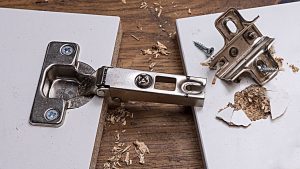 MDF, HDF, and MFC (Particle Board) cabinet doors can be finished in one of two ways. The first is paint. The second is thermofoil. Paint can only be used effectively on MDF and HDF. When painting, both must be sealed and primed using high-quality products. The primer is a heavy bonded primer that applies thick. This thick primer fills and hides all the imperfections. The actual paint is typically one or two very thin coats or a thin coat of tinted lacquer. Tinted lacquer is common on white MDF and HDF cabinets. Therefore, painted, or lacquered MDF and HDF cabinets scratch, dent, and nick easily. It’s nearly impossible to touchup either of these cabinet types and make them look new again. MDF and particle board cabinet doors do not hold screws and hardware securely and both tend to loosen and fall out.
MDF, HDF, and MFC (Particle Board) cabinet doors can be finished in one of two ways. The first is paint. The second is thermofoil. Paint can only be used effectively on MDF and HDF. When painting, both must be sealed and primed using high-quality products. The primer is a heavy bonded primer that applies thick. This thick primer fills and hides all the imperfections. The actual paint is typically one or two very thin coats or a thin coat of tinted lacquer. Tinted lacquer is common on white MDF and HDF cabinets. Therefore, painted, or lacquered MDF and HDF cabinets scratch, dent, and nick easily. It’s nearly impossible to touchup either of these cabinet types and make them look new again. MDF and particle board cabinet doors do not hold screws and hardware securely and both tend to loosen and fall out.
Thermofoil
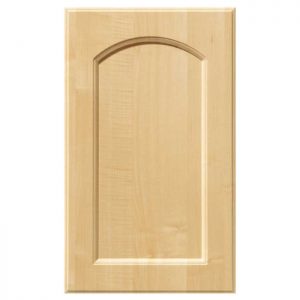 |  |
These doors have a heat activated, plasticized vinyl surface finish. The plastic material can take any shape. Thermofoil doors, cabinets, and drawers can be a solid color or made to look like real wood grain cabinets.
Thermofoil cabinet doors look and feel very similar to finished wood cabinet doors. They are available in all the same styles as wood doors. Many retailers and manufacturers use the terms Rigid Thermal Foil (RTF), Ready-To-Assemble (RTA), and Laminate Cabinet Doors (LCD) to describe thermofoil.
Particle board (MFC) cabinet doors often use a thin veneer on the front and back sides. Thin strips of wood veneer are applied to the sides of MFC doors using a process called “Edge Banding”. This further conceals the particle board. This also hides the particle board material on the sides and edges. Edge banding (thin wood strips – comes in a roll) give the appearance of a wood cabinet door. It can be very deceptive.
Thermofoil applied over MDF, HDF, and MFC (particle board) cabinets, doors, and drawers are significantly cheaper (both ways) than real wood.
To the untrained eye, it is nearly impossible to tell the difference between solid wood and thermofoil cabinets. It is perfectly legal to call solid wood, MDF, HDF, and MFC cabinets, doors, and drawers “solid wood”. That low price estimate you received for solid wood cabinets is likely MDF, HDF, or MFC (particle board). Make sure you are getting solid wood cabinets, not the cheap junk. Make sure the person you are buying your cabinets, doors, and drawers from has a solid reputation for honesty and high moral and ethical standards.
Thermofoil over MDF, HDF, and MFC
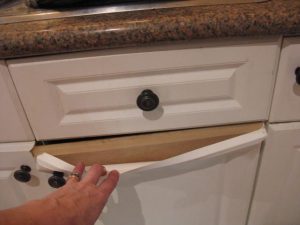 Environmental regulations make the adhesive properties in thermofoil less than satisfactory when applying to MDF, HDF, and MFC. Increasing numbers of customers who installed thermofoil doors, drawers, and cabinets are discovering their mistake. The most common product used to cover MDF, HDF, and MFC cabinet doors, drawers, and boxes is thermofoil. Why? It’s cheap – both ways! DAD’s Construction only uses solid wood for our cabinet doors, drawers, and face fronts. We use plywood on our boxes. With our cabinets, you never have to worry about everything falling apart. They are strong, durable, and beautiful!
Environmental regulations make the adhesive properties in thermofoil less than satisfactory when applying to MDF, HDF, and MFC. Increasing numbers of customers who installed thermofoil doors, drawers, and cabinets are discovering their mistake. The most common product used to cover MDF, HDF, and MFC cabinet doors, drawers, and boxes is thermofoil. Why? It’s cheap – both ways! DAD’s Construction only uses solid wood for our cabinet doors, drawers, and face fronts. We use plywood on our boxes. With our cabinets, you never have to worry about everything falling apart. They are strong, durable, and beautiful!
What about the Cabinet Frames (Boxes)?
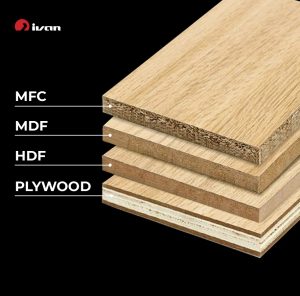 The picture on the right illustrates the four types of materials used to construct cabinet boxes. We’ve already talked about MFC (Melamine Faced Chipboard . . . particle board) and MDF (Medium-Density Fibreboard). HDF (High Density Fiberboard) is also an engineered wood product. Made from wood fiber extracted from chips and pulped wood waste. Using formaldehyde resin adhesives under immense pressure and heat, MDF and HDF takes its shape.
The picture on the right illustrates the four types of materials used to construct cabinet boxes. We’ve already talked about MFC (Melamine Faced Chipboard . . . particle board) and MDF (Medium-Density Fibreboard). HDF (High Density Fiberboard) is also an engineered wood product. Made from wood fiber extracted from chips and pulped wood waste. Using formaldehyde resin adhesives under immense pressure and heat, MDF and HDF takes its shape.
Look at the plywood. Notice how much thicker the wood laminate is on both sides. The laminate on MFC, MDF, and HDF is very thin. MFC, MDF, and HDF can’t compete with the superior strength and durability of plywood. Plywood is the best choice for cabinet boxes. Plywood does not soak up water and liquids like MFC, MDF, and HDF. This makes it less susceptible to damage. The grains in plywood makes it easier to stain. Plywood gets its strength by bonding multiple layers of veneer together. This process allows plywood to hold screws tightly. The multiple layers give each screw more holding power and strength.
Are there different types of cabinet doors?
Yes! These are Traditional, Transitional, and Modern.
Types of Cabinet Doors
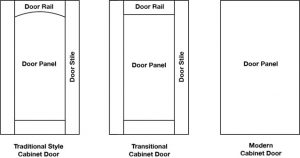
Traditional Style Cabinet Doors
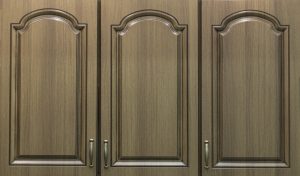
The classic traditional style cabinet door has a raised panel design. Raised panel designs are very traditional – They always have a floating center panel outlined by a carved design. The center panels can be rectangular with sharper edges, rounded with softer features, or have a more arched appearance.
Transitional Style Cabinet Door Panels
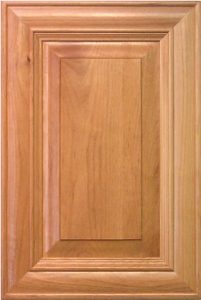 | 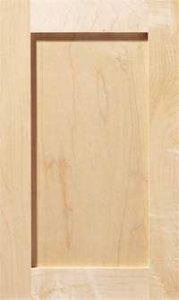 | 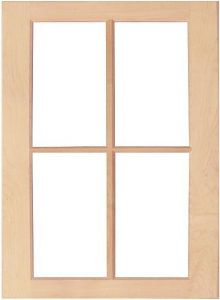 |
| Recessed | Shaker | Mullion |
There are three main options for these transitional style panels: Recessed, Shaker and Mullion. Not too historic or sleek, transitional cabinet doors are a mix of modern and traditional.
Recessed cabinet doors have a depressed center panel. This adds a more dimension and subtle detail to cabinets. These five-piece doors add elegance.
Shaker cabinet door panels are one of the most popular cabinet options out there – and for good reason. Their five-piece cabinet door design with recessed center panels gives them a simple and versatile look.
Mullion cabinet door panels have glass panes as their door panels. This gives complete transparency inside your cabinets. Mullion cabinet doors are ideal to use as a bookshelf or to hold glassware, beverages, and dining room essentials. Whatever items you decide to keep in these cabinets will be on full display. Adding strips of wood (moldings) to the glass panel gives them a more decorative aesthetic.
Modern Style Cabinet Door Panels
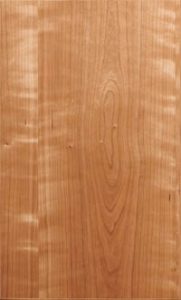 | 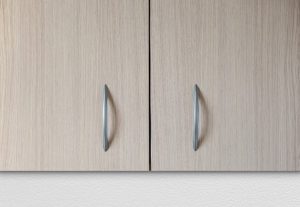 |
Modern cabinet doors are flat and considered very European. There won’t be a rectangular/square frame around the door panel (no stile or rail). Using modern or ultra-modern hardware for this type of cabinet tends to be a great choice, given the sleek look of the cabinet door.
Always Hire a Reliable and Dependable Contractor to Remodel your Home
 Always work with a trustworthy contractor like DAD’s Construction when remodeling your bathroom, kitchen, and full interior. We are experts in home remodeling who can manage projects in an efficient manner. DAD’s Construction will do everything to minimize the possibility of change orders. Our team will make sure we have all the necessary information to prepare a proposal that meets your requirements.
Always work with a trustworthy contractor like DAD’s Construction when remodeling your bathroom, kitchen, and full interior. We are experts in home remodeling who can manage projects in an efficient manner. DAD’s Construction will do everything to minimize the possibility of change orders. Our team will make sure we have all the necessary information to prepare a proposal that meets your requirements.
Rest assured that we will provide you with a detailed, by line-item contract. We will make sure that the contents of this agreement are properly and clearly communicated to you. If you have questions or need updates regarding your project, we will always answer your inquiries.
How Can I Receive More Information on Remodeling my Home?
If you would like more information on enjoying the best experience remodeling your bathroom, kitchen, and home interior in Orange County, call Dan at (949) 380-0177 or at dan@dadsconstruction.com for a free in home consultation. DAD’s serves all of South Orange County California. This includes Lake Forest, Mission Viejo, Foothill Ranch, Portola Hills, Ladera Ranch, Irvine, San Clemente, Dana Point, San Juan Capistrano, Rancho Santa Margarita, Coto de Caza, Dove Canyon, Laguna Niguel, Laguna Hills, Newport Beach, and Aliso Viejo.
“Taking Care of Your Home . . . The Way We Would Our Own”
Daniel A. Derkum is the owner of DAD’s Construction. DAD’s is a leading South Orange County, California design-and-build remodeling and renovation Contractor. See https://www.dadsconstruction.com. © DAD’s Home Services & Construction, Inc. All Rights Reserved.
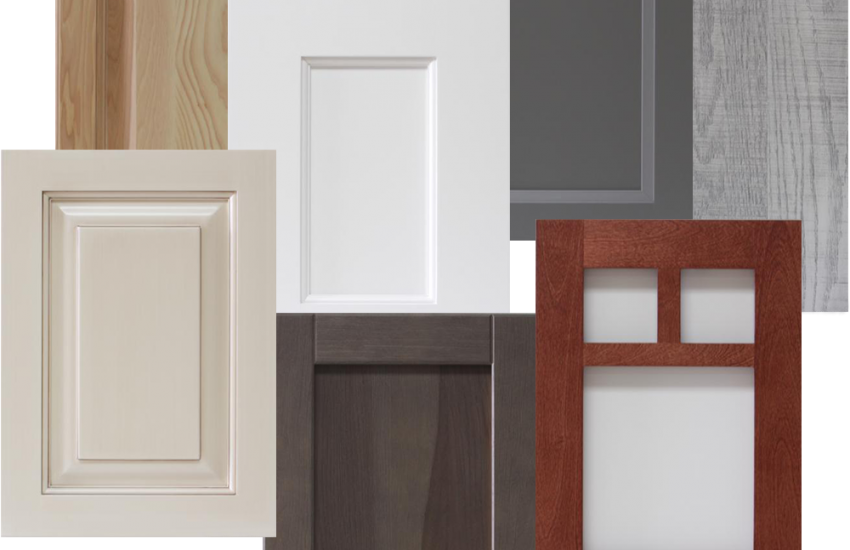
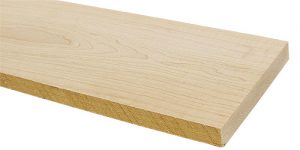
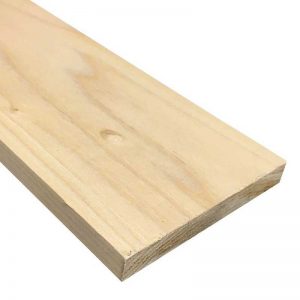
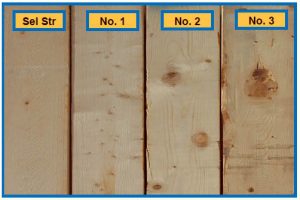 1 Common – A typical thrift or “shop” grade. These boards yield 66-2/3 percent clear face cuttings on the best side. This grade of wood delivers good value when small pieces are used.
1 Common – A typical thrift or “shop” grade. These boards yield 66-2/3 percent clear face cuttings on the best side. This grade of wood delivers good value when small pieces are used.